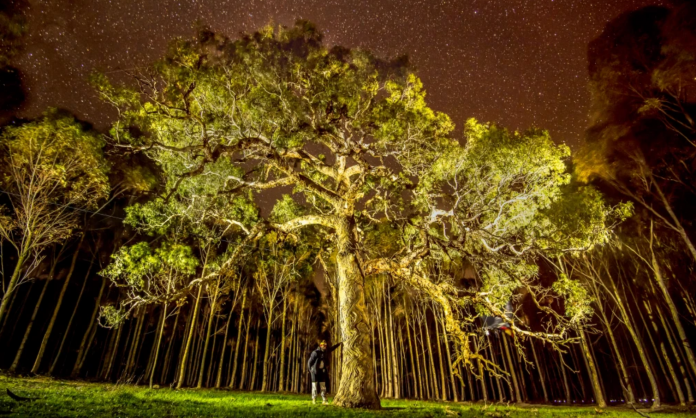On the same day Victorians were celebrating Premier Daniel Andrews’ announcement of the easing of the 112-day COVID-19 lockdown, the state government oversaw the felling of a 350-year-old tree sacred to the Djab Wurrung people in central Victoria. The tree was destroyed to make way for a multi-million-dollar highway upgrade.
More than 50 protesters were attacked and arrested by Victoria Police, who weaponised COVID-19 laws by fining at least 40 protesters for failing to comply with COVID-19 measures. A further ten protesters were arrested for obstructing police.
The $672 million Western Highway upgrade between Ballarat and Stawell began in 2013, but work on the Buangor to Ararat section did not begin until June 2018. Work in this section will result in the destruction of more than 3,000 trees, including at least 200 which hold cultural significance to the Djab Wurrung people. Among the trees are traditional birthing trees, to which Aboriginal women have come to give birth for hundreds of generations. The area holds “a deep intimate connection for Djab Wurrung women”, wrote Djab Wurrung woman and recently resigned member of the First Peoples’ Assembly of Victoria, Sissy Eileen Austin, in the Guardian.
When work first began on the section of the highway in June 2018, Djab Wurrung protesters established a Heritage Protection Embassy, calling for the highway to be rerouted and the area protected. According to the embassy’s website, not only are the birthing trees located on sacred women’s country, but they are also part of the songlines, which “connect us to the beginning of time, back to our spirit ancestors, our creators”.
In Aboriginal culture, songlines act as navigational tracks for safe travel across country, while also telling the history of the land, animals and plants. The songs sung along the songlines are the means by which cultural knowledge, values and practices are retained and passed down. The destroyed tree was known to the Djab Wurrung as a “directions tree”, which is a tree planted after the birth of a child where the placenta is mixed with the seed and the resulting tree becomes a source of spiritual guidance and connection to land and ancestors for the child.
The Andrews government has negotiated the highway project with the Indigenous custodians via the 2006 Victorian Aboriginal Heritage Act. But heritage acts and the process surrounding them are seriously flawed. In Victoria, in order to be recognised as the “primary guardians, keepers and knowledge holders of Aboriginal Cultural Heritage” under the Aboriginal Heritage Act, traditional owners must apply to become a “Registered Aboriginal Party”. To be recognised, they must become an incorporated organisation under the 2006 Aboriginal and Torres Strait Islander Corporations Commonwealth Act and be either a registered Native Title Holder with a Native Title Agreement or a Traditional Owner Entity Group with recognition and settlement agreement as part of the 2010 Victorian Traditional Settlement Act.
The problem with this, notes Deakin University anthropologist Associate Professor Melinda Hinksonin in a 5 November article for Arena, is that it “ensures that Aboriginal owners and custodians who refuse to participate on these terms will not be recognised”, resulting in them being “excluded from formal processes of consultation”.
Under the Victorian act, the current Registered Aboriginal Party for Djab Wurrung country is the Eastern Maar Aboriginal Corporation (EMAC). EMAC took over the role in February of this year, after Martang—the original Registered Aboriginal Party, which had signed off on the highway extension in 2013—became defunct. In a media statement issued on 28 October, EMAC noted that “despite [the directions tree’s] age and majesty, extensive re-assessments did not reveal any characteristics consistent with cultural modification”. They went on to explain that the EMAC had previously won a significant “realignment” of the highway project, resulting in the preservation of 16 trees, two of which were birthing trees, as well as “marker”, “directions” and “grandmother” trees. But other Djab Wurrung people disagree with this assessment and argue the trees are of cultural significance.
University of Sydney director of Aboriginal and Torres Strait Islander Research, Professor Jaky Troy, told the ABC that Indigenous custodians often face a situation of “deciding which child to kill” when taking part in heritage negotiations. Troy, a Ngairgu woman, explained that the Djab Wurrung “were put in a position where something was going to have to go”. That is, traditional owners are forced into making pragmatic decisions in order to save some part of their cultural heritage, while being forced to sacrifice others.
This fact was further highlighted by EMAC’s chair, Jason Mifsud, in the same interview. Mifsud explained that despite earlier advocating for the directions tree to be protected, they were not able to save it because Aboriginal groups are “not negotiating from a position of power”. Instead, “you’re essentially, as a result of the Aboriginal Heritage Act, still the last in line in regards to protecting and preserving cultural heritage”.
In the aftermath of the destruction of the directions tree, prominent Aboriginal activist and Djab Wurrung woman Marjorie Thorpe has won a three-week injunction to stop construction. The case will return to the Supreme Court on 19 November. In the meantime, the Djab Wurrung Heritage Protection Embassy activists are calling for the return of the destroyed tree and are continuing their campaign.








